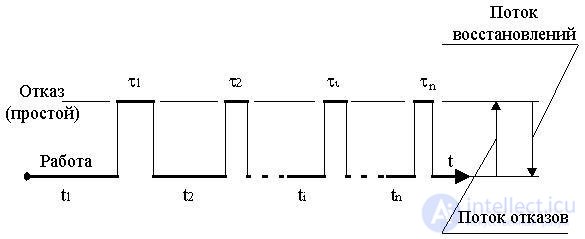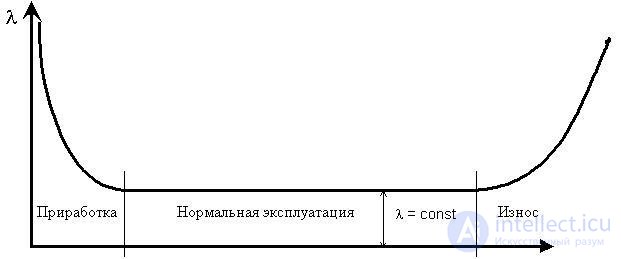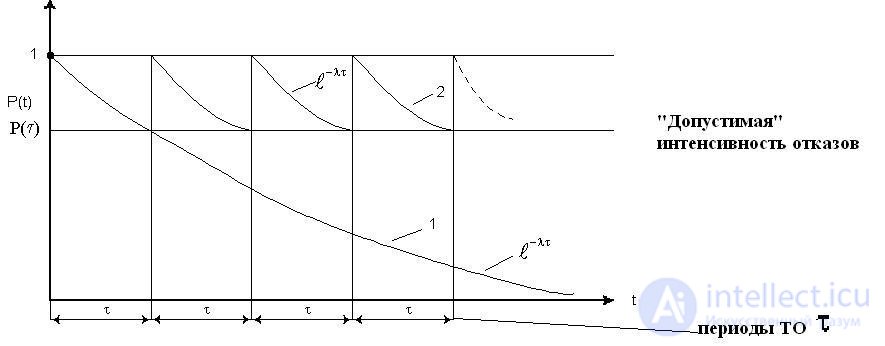Lecture
Maintenance (according to GOST 18322-78) is a complex of operations or an operation to maintain the health or health of the product when used for its intended purpose, waiting, storage and transportation.
The task of maintenance of computer equipment
(CBT) is:
"Ensuring reliable (correct and uninterrupted) operation of computer equipment, which allows users to use the full extent of information files of the organization and other third-party information sources."
Consequently, the concept of technical servicing of SVT is inseparably linked with its reliability.
In accordance with GOST 27.002-89 "Reliability in engineering. Basic concepts. Terms and definitions." Reliability means the property of an object to preserve in time in established limits of values of all parameters characterizing the ability to perform the required functions in the specified modes and conditions of use, maintenance, repair, storage and transportation.
Reliability is a complex property of an object, which, depending on the purpose of the object and the conditions of its stay, includes the following concepts:
Reliability - the property of an object to continuously maintain a healthy state for some time or an operating time.
Durability - object property to maintain a healthy state when installed system maintenance and repair.
Maintainability - object property consisting in fitness to maintain and restore working condition through maintenance and repair.
Persistence - object property to keep within specified limits values of parameters characterizing the ability of an object to perform the required functions during and after storage and / or transportation.
These most important properties of reliability characterize certain technical conditions of an object.
According to GOST 27.002-89, there are five main types of technical condition of objects.
Good condition Condition of the object where it corresponds all requirements of regulatory technical and (or) design (project) documentation.
Faulty condition. Condition of the object under which he is not meets at least one of the requirements of regulatory technical and (or) design (project) documentation.
Healthy state. Condition of the object at which values all parameters characterizing the ability to perform specified functions comply with the requirements of regulatory and (and) design (project) documentation.
Inoperable condition. Condition of the object at which values at least one parameter characterizing the ability to perform specified functions does not meet the requirements of regulatory and technical and (or) design (project) documentation.
Limit state. Condition of the object in which its further operation is unacceptable or impractical, or the restoration of its operational state is impossible or impractical.
The transition of an object (product) from one higher technical state to a lower level usually occurs as a result of events: damage or failure.
failure - this event, malfunctioning object state.
damage - event, malfunctioning the state of the object while maintaining a healthy state.
In GOST 15467-79, another concept has been introduced that reflects the state of the object — a defect.
A defect is every single object mismatch. established standards or requirements. The defect reflects a condition other than failure.
In accordance with GOST 27.002-89, indicators are used to quantify reliability: characterizing readiness and efficiency of using technical objects:
2.1.1. Probability of no-failure operation Probability of no-failure operation - this is the probability what is within
jobs jobs object failure does not occur. In practice, this indicator is determined by statistical evaluation.

n (t) is the number of failed objects in time t.
From the definition of the probability of failure-free operation, it is clear that this characteristic is a function of time, and it is a decreasing function and can take values from 1 to 0.

The graph of the probability of failure-free operation of the object is depicted in Figure 1. As can be seen from the graph, the function P (t) characterizes the change in reliability over time and is a fairly visual estimate.
For example, 1000 samples of the same type of HDD were put to the test, that is, No = 1000. When tested, the failed elements were not replaced with serviceable ones. During time t, 10 drives failed. Therefore, P (t) = 0.99 and our confidence is that any drive from this sample will not fail in time t with probability P (t) = 0.99.
Sometimes it is practically expedient to use not the probability of failure-free operation, but the probability of failure Q (t). Since operability and failure are incompatible and opposite states, their probabilities [4,13] are related by the dependency:
P (t) + Q (t) = 1,
Consequently:
Q (t) = 1 - Р (t).
If we set the time T, which determines the object's time to failure, then P (t) = P (T> t), that is, the probability of no-failure operation is the probability that
the time T from the moment the object is turned on to its failure will be greater than or equal to the time t, during which the probability of failure-free operation is determined .
2.1.2. Mean time to failure
Mean time to failure is the mathematical expectation of the object's time to the first failure T1.

2.3.1. Average recovery time
Average Recovery Time - this is the mathematical expectation of the recovery time of the object after a failure. From the definition it follows that  , (2.17)
, (2.17)
where n is the number of restorations equal to the number of failures; - time spent on recovery (detection, search for the cause and elimination of failure), in hours.
2.4. Comprehensive reliability indicators
2.4.1. Availability The process of functioning of the recovered object can
to present as a sequence of alternating intervals of health and recovery (idle).

Availability factor - this is the probability that the object will be in working condition at an arbitrary point in time, except for planned periods during which the use of the object for its intended purpose is not foreseen. This indicator simultaneously assesses the properties of health and maintainability of the object.
For one repaired object availability factor 
From the expression 2.23 it can be seen that the object availability factor can be increased by increasing the time between failures and reducing the average recovery time. To determine the availability factor, a sufficiently long calendar period of the facility operation is required.
2.4.2. Operational readiness ratio
COG operational readiness ratio defined as probability that the object will be in working condition at an arbitrary point in time (except for planned periods during which the use of the object for its intended purpose is not foreseen) and, from this moment on, will work without fail within a specified time interval.
From the probabilistic determination it follows that
 , (2.23)
, (2.23)
where KG - availability factor; P (tp) - the probability of failure-free operation of the object during the time (tp) required for reliable use as intended.
The experience of operating many electronic devices shows that they are characterized by three types of dependences of the failure rate on time (Figure 3), corresponding to the three periods of life of these devices.

Break-in - the interval is characterized by an increased level of failures, the failure rate is large, but decreases with time;
Normal operation - the failure rate is not significant, failure rate is large almost constant;
Depreciation - the level of failure increases failure rate is growing over time.

The exponential nature of the probability of failure-free operation makes it possible to determine periods of maintenance as the time interval during which the probability of failure-free operation of the STS does not fall below a given value. Consequently, the period of maintenance will be different for different types of SVT and is determined by the level of requirements (permissible failure rate) imposed on SVT.
Comments
To leave a comment
Diagnostics, maintenance and repair of electronic and radio equipment
Terms: Diagnostics, maintenance and repair of electronic and radio equipment